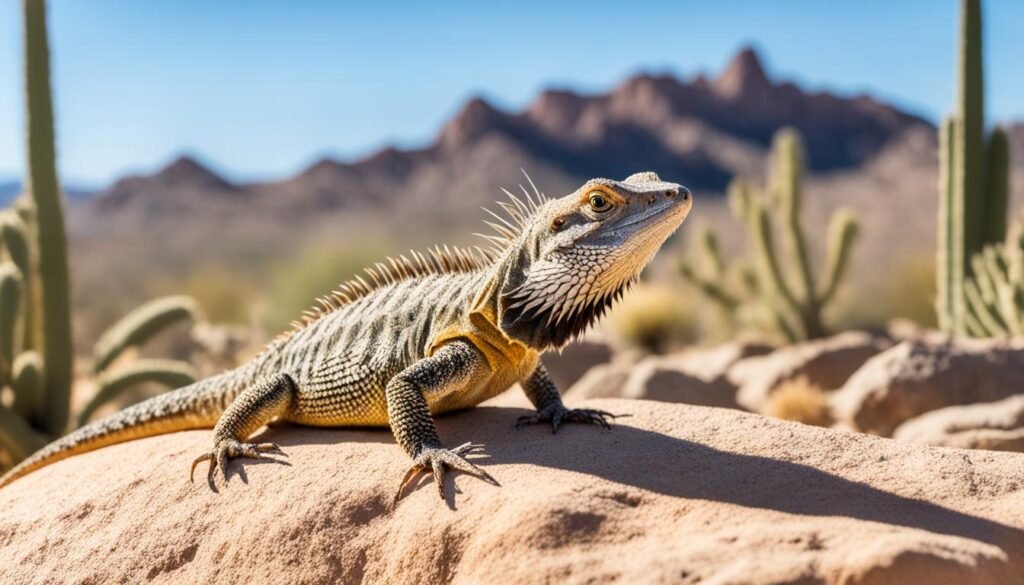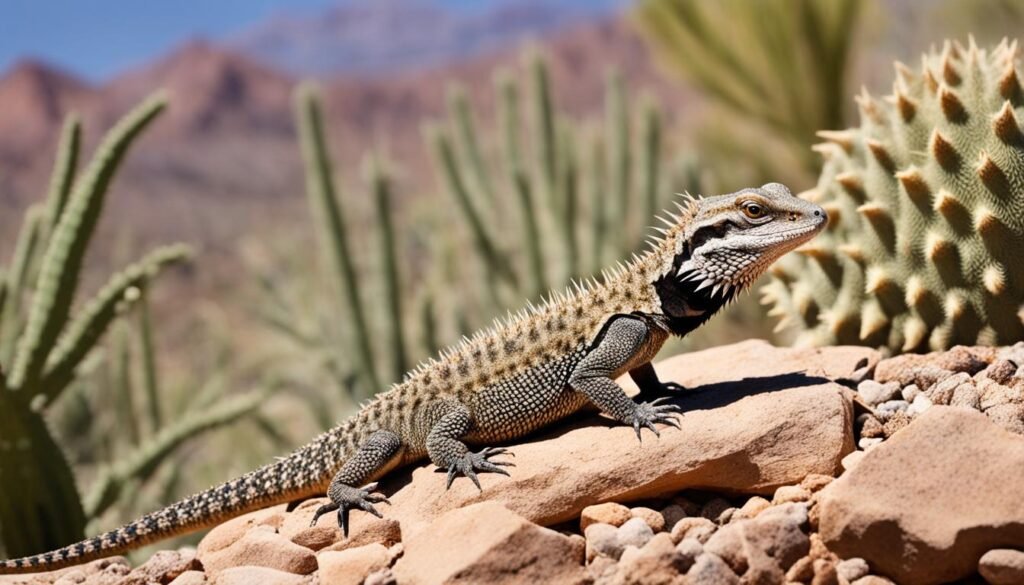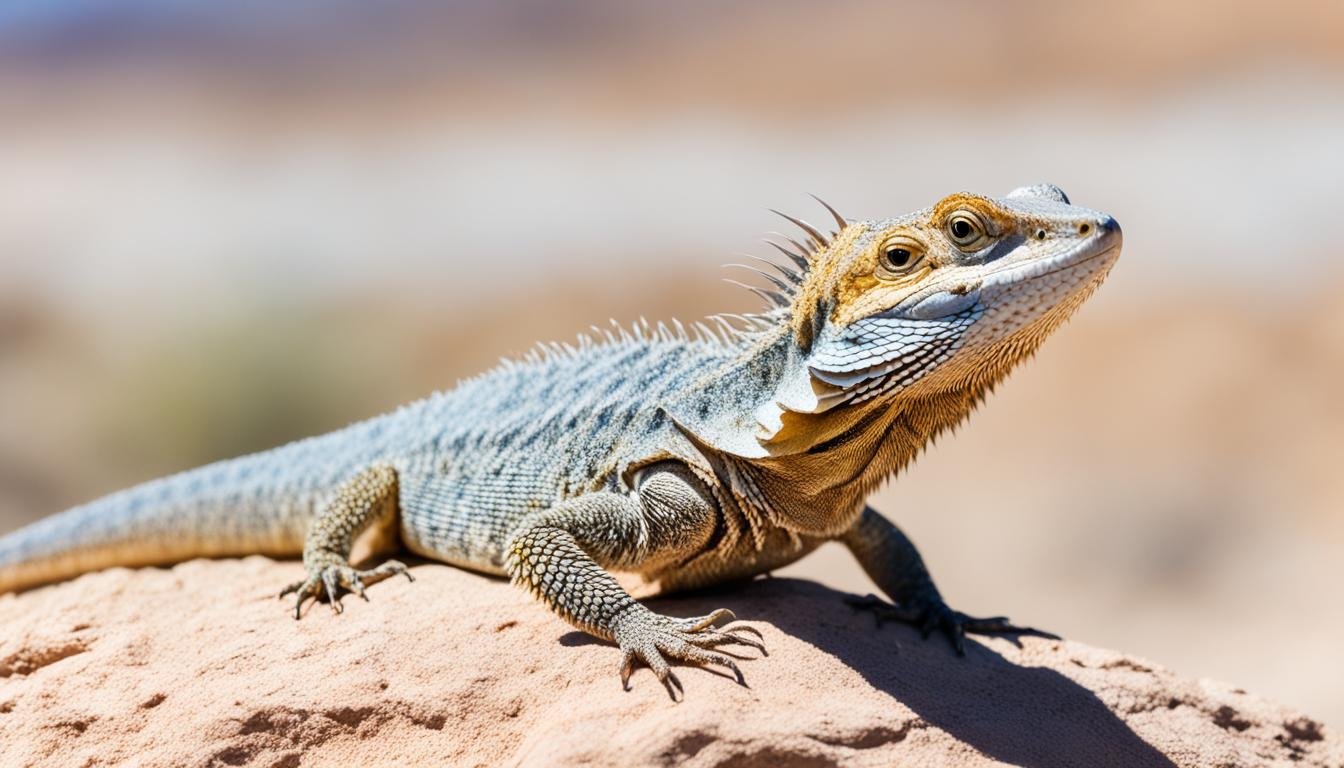Did you know that spiny-tailed lizards have unique adaptations that allow them to survive in the harsh conditions of the Sahara Desert? These reptiles, also known as agamid lizards or Uromastyx, have fascinating behaviors and habitat requirements that make them intriguing creatures to study and care for.
- Spiny-tailed lizards, or Uromastyx, are native to the Sahara Desert and can be found in countries such as Morocco, Mauritania, and Egypt.
- They inhabit deserts, bushes, and rock crevices and have specific habitat requirements for their survival.
- These lizards are primarily herbivorous but may occasionally consume insects as part of their diet.
- They have unique adaptations, including using their thick, sharp tails as weapons and extracting most of their water from their food.
- Spiny-tailed lizards are solitary and territorial creatures, both males and females.
Physical Description of Spiny-Tailed Lizards
When it comes to physical characteristics, the spiny-tailed lizard, scientifically known as Uromastyx acanthinurus, boasts some distinctive features. These fascinating reptiles can reach a body length of up to 140 mm, with a tail length of 145 mm.
During their juvenile stage, spiny-tailed lizards typically display a gray coloration adorned with dark spots. However, as they mature, their color palette expands to include shades of gray, red, orange, green, and yellow. These vibrant color variations make them a visually stunning addition to any reptile lover’s collection.
While their body length and tail length may vary, it is their spiny tails that truly stand out. These lizard’s tails are equipped with thick, pointed scales that serve both as a defensive weapon and as a mechanism of visual display.
Take a moment to appreciate the stunning beauty of a spiny-tailed lizard in the image below:
| Physical Characteristics | Description |
|---|---|
| Body Length | Up to 140 mm |
| Tail Length | 145 mm |
| Juvenile Colors | Gray with dark spots |
| Adult Colors | Gray, red, orange, green, or yellow |
| Unique Feature | Thick, spiny tail |
Behavior of Spiny-Tailed Lizards
Spiny-tailed lizards are fascinating creatures with unique behavioral traits. As diurnal reptiles, they are most active during the day, utilizing the sunlight to their advantage. A key characteristic of their behavior is their inclination to bask outside their burrows, soaking up the warmth and energy from the sun.
The spiny-tailed lizard is primarily a solitary and reclusive species, spending much of its time alone. However, during the breeding season, both males and females engage in complex courtship rituals to attract mates. These rituals can involve elaborate displays of color, as well as specific movements and vocalizations.
Territoriality is another prominent aspect of spiny-tailed lizard behavior. They fiercely defend their territories, marking their boundaries with scent and engaging in aggressive displays towards intruders. This territorial behavior ensures that each lizard has access to sufficient resources for survival.
When faced with threats, spiny-tailed lizards have an effective line of defense. Their tails, which are thick and spiny, serve as formidable weapons. When approached by predators, they will lash out with their tails, deterring potential attackers and protecting themselves from harm.
Seeking safety is of utmost importance to spiny-tailed lizards. While they are active during the day, they often retreat to the safety of their underground tunnels to rest and seek shelter from the intense heat or potential predators. These tunnels provide them with a secure environment where they can rest undisturbed until it’s time to venture out again.
Interesting Facts about Spiny-Tailed Lizard Behavior:
- Spiny-tailed lizards are known for their diurnal behavior, making them more active during the day than at night.
- Basking in the sun helps spiny-tailed lizards regulate their body temperature, allowing them to stay warm and metabolically active.
- Their territorial behavior ensures that resources such as food, water, and shelter are available to them within their designated areas.
- Their tails serve both as a means of communication, through various tail movements, and as a powerful weapon for self-defense.
Reproduction and Breeding of Spiny-Tailed Lizards
During the breeding season which occurs in March and April, spiny-tailed lizards engage in fascinating courtship rituals. Males perform elaborate displays and gestures to attract potential mates. These rituals involve head-bobbing, tail-waving, and body posturing to demonstrate their fitness and suitability as partners.
Following successful courtship, females will lay a single clutch of eggs in May or June. However, unlike some other reptiles, spiny-tailed lizards do not provide nest protection for their eggs or hatchlings. Instead, they deploy a unique strategy by depositing their eggs in the burrows of other animals, such as rodents or reptiles, to ensure the highest chances of survival.
The clutch size can range from 4 to 20 eggs, depending on the age and health of the female. The eggs are oval-shaped and have a leathery texture, providing them with protection from the harsh desert environment. Incubation typically lasts for around 60 to 75 days.
Once the hatchlings emerge from the eggs, they are considered precocial, meaning they are relatively independent from birth. They possess the necessary skills and instincts to survive on their own in the harsh desert environment. While young spiny-tailed lizards may consume insects as an additional food source, adults primarily rely on vegetation to meet their nutritional needs.
This unique reproductive strategy of spiny-tailed lizards showcases their remarkable adaptation to desert life. By capitalizing on the protective burrows of other animals, they increase the chances of their offspring’s survival in a challenging environment.
Habitat and Geographic Range of Spiny-Tailed Lizards

Spiny-tailed lizards are fascinating creatures that have adapted to thrive in the harsh desert environments of the Sahara. They can be found across a wide range of countries, including Morocco, Mauritania, and Egypt. Their ability to survive in arid climates is truly remarkable, and they have specific habitat requirements that enable them to thrive in these challenging conditions.
Desert Habitat: Spiny-tailed lizards inhabit various desert environments within the Sahara Desert. Their preferred habitats include arid regions with sparse vegetation, such as sandy dunes, rocky slopes, and gravel flats. These lizards have adapted to the extreme heat and lack of water resources found in desert habitats.
Bushes and Rock Crevices: Within the desert habitat, spiny-tailed lizards seek refuge and shelter in bushes and rock crevices. These provide them with protection from predators and extreme temperatures. The lizards use these hiding spots to rest, seek shade, and escape the scorching sun.
By utilizing their surroundings and adapting their behavior, spiny-tailed lizards have successfully carved out a niche in the challenging desert ecosystem. Their ability to find shelter in bushes and rock crevices contributes to their survival in such a harsh environment.
Geographic Range:
Spiny-tailed lizards have a broad geographic range within the Sahara Desert region. They can be found in Morocco, Mauritania, and Egypt, as well as other countries that fall within the Sahara Desert’s expanse.
Below is a table showcasing some of the locations where spiny-tailed lizards are typically found:
| Country | Specific Locations |
|---|---|
| Morocco | Western Sahara, Souss-Massa |
| Mauritania | Adrar, Tagant, Hodh El Gharbi, Assaba |
| Egypt | South Sinai, Western Desert |
These are just a few examples of the countries and regions where spiny-tailed lizards can be found. Their distribution is influenced by factors such as the availability of suitable habitat, climate conditions, and the presence of prey and predators.
The image above showcases a spiny-tailed lizard in its natural desert habitat, highlighting its unique adaptations and habitat preferences.
Diet of Spiny-Tailed Lizards
Spiny-tailed lizards are fascinating creatures with a primarily herbivorous diet. These reptiles have a significant preference for leafy greens, which make up the majority of their nutrition. However, they occasionally supplement their diet with insects such as crickets, grasshoppers, and ants.
Insect Consumption
While spiny-tailed lizards are predominantly herbivorous, their occasional consumption of insects serves several purposes. Insects provide a source of protein and essential nutrients that may be lacking in their plant-based diet. They also seem to enjoy the occasional crunchy treat, adding variety to their feeding habits.
Specialized Digestive Adaptations
Spiny-tailed lizards have evolved specialized digestive adaptations to process both plant matter and insects. Their digestive system is designed to efficiently extract nutrients from vegetation, making use of hindgut fermentation. This process allows them to break down tough plant fibers and extract the maximum amount of nutrients from their plant-based diet.
The occasional consumption of insects is a supplementary behavior and does not significantly impact their herbivorous nature. These adaptable reptiles have found a balance between their herbivorous diet and the occasional insect feast, ensuring they receive all the necessary nutrients for their well-being and survival.
Conservation Status of Spiny-Tailed Lizards

The conservation status of spiny-tailed lizards is a topic that warrants attention. While spiny-tailed lizards themselves are not currently protected species, it is important to note that some related species receive protection under the Convention on International Trade in Endangered Species of Wild Fauna and Flora (CITES).
The International Union for Conservation of Nature (IUCN) does not provide a specific conservation status for spiny-tailed lizards. However, their populations may face threats due to habitat destruction and illegal wildlife trade.
Habitat destruction, including the conversion of natural land into agricultural or urban areas, can significantly impact the survival and well-being of spiny-tailed lizards. As their habitat dwindles, the likelihood of finding suitable resources for food, shelter, and reproduction decreases.
Furthermore, the illegal wildlife trade poses a significant threat to spiny-tailed lizards. These reptiles are often sought after by collectors due to their unique appearance and fascinating behaviors. The demand for these lizards in the exotic pet trade can lead to over-collection from the wild, disrupting natural populations and potentially pushing them towards endangerment.
Conservation Efforts and Management
Efforts to conserve spiny-tailed lizards and their habitats are essential for their long-term survival. However, due to the limited research and information available on these lizards, appropriate management strategies are challenging to develop.
Conservation organizations, researchers, and governments must work together to conduct thorough population assessments, monitor habitat loss, and combat illegal wildlife trade. By gathering more data on population size, distribution, and genetic diversity, conservation efforts can be targeted effectively.
It is crucial to raise awareness about the importance of preserving spiny-tailed lizards and their habitats. Engaging local communities, educating the public, and promoting responsible pet ownership can contribute to the overall conservation of these remarkable reptiles.
Unique Adaptations of Spiny-Tailed Lizards
Spiny-tailed lizards have evolved several remarkable adaptations that enable them to thrive in their harsh desert habitat. These adaptations not only provide them with survival advantages but also make them fascinating creatures to study.
One of the most distinctive features of spiny-tailed lizards is their tail weapon. Their tails are thick and adorned with sharp spines, which they use as formidable defensive weapons. When threatened by predators, they whip their tails with impressive force, inflicting injuries or delivering painful strikes. This tail defense mechanism helps deter potential threats and ensures the lizards’ safety.
Another remarkable adaptation of these lizards is their ability to extract most of their water needs from their food. Living in hot climates with limited access to water sources, spiny-tailed lizards have adapted to rely on the moisture content of their plant-based diet to meet their hydration requirements. This adaptation minimizes their need for drinking water and allows them to survive in arid environments where water scarcity is a significant challenge.
In addition to their water extraction adaptation, spiny-tailed lizards possess a unique salt gland near their eyes. This gland plays a critical role in maintaining their electrolyte balance in hot climates. By excreting excessive salts through the gland, these lizards prevent salt buildup in their bodies, which could be detrimental to their health. This adaptation enables them to thrive and survive in environments with high levels of salinity, ensuring their physiological well-being.
Overall, the spiny-tailed lizard’s tail weapon, water extraction adaptation, and salt gland exemplify the remarkable resilience of these reptiles in their desert habitat. These adaptations, honed over generations, are key factors in their survival and demonstrate their ability to thrive in challenging environments.
| Unique Adaptations of Spiny-Tailed Lizards |
|---|
| Tail weapon |
| Thick tails with sharp spines used for defense |
| Water extraction |
| Ability to obtain most water needs from their food |
| Salt gland |
| Gland near eyes that excretes excess salts |
Lifespan and Size of Spiny-Tailed Lizards
When it comes to the Egyptian spiny-tailed lizard, scientifically known as Uromastyx aegyptia, they can reach impressive sizes. These lizards can grow to a length of 3.2 to 4 feet, making them a substantial reptile in the desert. On average, they weigh between 1 to 2 pounds, which adds to their sturdy build. With their unique appearance and size, spiny-tailed lizards are truly captivating creatures.
In terms of lifespan, spiny-tailed lizards can live quite a long time. In the wild, their lifespan is typically around 15 years. However, when kept in captivity under optimal conditions, they can live up to 30 years. This longer lifespan in captivity provides individuals with an opportunity to appreciate and care for these incredible reptiles over an extended period.
The Size Range of Spiny-Tailed Lizards
| Aspect | Range |
|---|---|
| Body Length | 3.2 to 4 feet |
| Weight | 1 to 2 pounds |
The Lifespan of Spiny-Tailed Lizards
| Environment | Lifespan |
|---|---|
| Wild | Average of 15 years |
| Captivity | Up to 30 years |
With their impressive size range and remarkable lifespan, spiny-tailed lizards are fascinating reptiles that captivate the imagination of enthusiasts and researchers alike. Observing these lizards in their natural habitat or providing them with suitable care and enclosure in captivity allows for a deeper appreciation of their unique attributes.
Fun Facts About Spiny-Tailed Lizards
Spiny-tailed lizards are fascinating creatures with unique characteristics and adaptations that make them stand out. In this section, we will explore some fun facts about these remarkable reptiles.
1. Thriving in Hot Temperatures
Spiny-tailed lizards are well-suited to endure scorching desert environments. They have the remarkable ability to tolerate extremely high temperatures, even basking in temperatures exceeding 115 degrees Fahrenheit. Their bodies have adapted to regulate heat and preserve water, allowing them to thrive in these harsh conditions.
2. Diverse Species
Did you know that there are over 10 different species of spiny-tailed lizards? Each species has its own unique characteristics, ranging in size, coloration, and behavior. From the Uromastyx acanthinurus found in the Sahara Desert to the Uromastyx aegyptia in Egypt, these diverse species showcase the adaptability and evolutionary success of these reptiles.
| Species | Size Range | Coloration | Geographic Range |
|---|---|---|---|
| Uromastyx acanthinurus | Length: Up to 140 mm Tail Length: 145 mm |
Gray, Red, Orange, Green, Yellow | Morocco to Egypt |
| Uromastyx aegyptia | Length: 3.2 to 4 feet Weight: 1 to 2 pounds |
Varies | Egypt |
3. Insect Consumption
While adults primarily consume vegetation as herbivores, young spiny-tailed lizards may feast on insects as a treat. These small insects provide a valuable source of protein and nutrients for their growing bodies. As they mature, their diet gradually shifts to predominantly plant-based.
Conclusion
In conclusion, understanding the behavior and habitat of spiny-tailed lizards provides valuable insights into their unique adaptations for survival in arid environments. These reptiles exhibit fascinating behaviors, such as using their tails as weapons for defense and extracting most of their water needs from their food.
However, their natural habitats face conservation challenges, making responsible management crucial for their long-term survival. By protecting their habitats and regulating illegal wildlife trade, we can ensure the continued existence of these remarkable creatures.
Additionally, learning about spiny-tailed lizards is not only educational but also fun. Their ability to tolerate extremely high temperatures and their diverse species make them intriguing subjects of study. Whether you are fascinated by their reptile behavior, their unique adaptations, or their fun facts, the spiny-tailed lizard is sure to capture your curiosity.
FAQ
What is a spiny-tailed lizard?
What is the behavior of spiny-tailed lizards?
How do spiny-tailed lizards reproduce?
Where do spiny-tailed lizards live?
What do spiny-tailed lizards eat?
Are spiny-tailed lizards protected?
What are some unique adaptations of spiny-tailed lizards?
How big do spiny-tailed lizards get?
What are some fun facts about spiny-tailed lizards?
References
| Organization Name | URL |
| International Reptile Conservation Foundation (IRCF) | https://www.ircf.org/ |
| Herpetological Conservation International | https://herpconservation.com/index.html |
| Society for the Study of Amphibians and Reptiles (SSAR) | https://ssarherps.org/about-ssar/ |


11 thoughts on “Understanding Spiny-Tailed Lizard Behavior & Habitat”